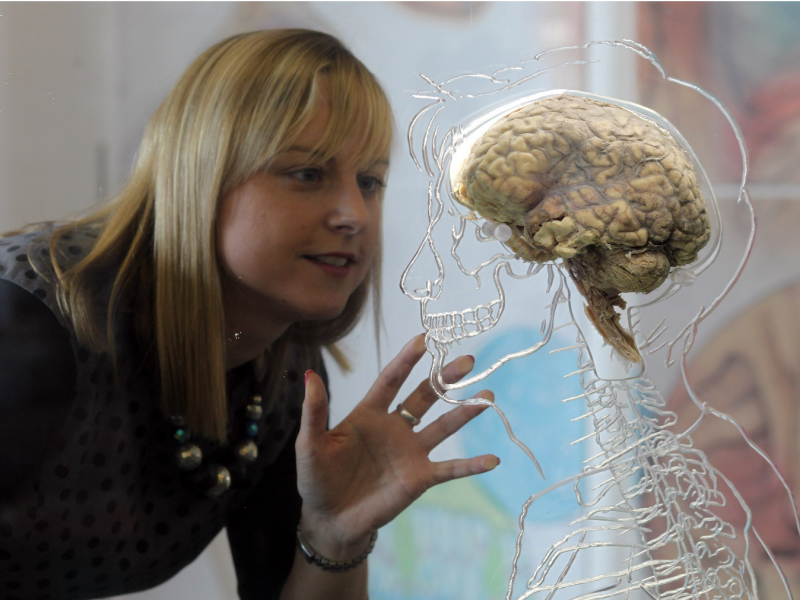However long you’ve been alive, chances are you’ve heard a completely incorrect “fact” about the brain. The human brain is notoriously complicated, and despite many advances in modern science, much of the organ remains a mystery.
That’s probably why, when someone hears a rumour about how the brain functions, they spread it – regardless of whether or not it’s true.
Here are 10 of the biggest and most widely believed misconceptions about the human brain, and why they’re wrong.
1. There are ‘left brain’ and ‘right brain’ people

According to popular culture and quizzes on Facebook, logical, analytical people have a “left brain” while creative and artistic types think with their their “right brain.”
But this isn't true. No scientific studies have really ever been able to prove people are dominated by either side of the brain.
In fact, in a study in 2013, researchers from the University of Utah examined the brains of more than 1,000 people, and found there was no significant difference among people in terms of their brain dominance. Essentially, by looking at MRI scans of brain activity, both sides of the brain were more or less equal in their neural networks and connectivity.
The "right or left brain" myth could have arisen from the work of Roger Sperry, who won a Nobel Prize for his research on patients with epilepsy. They were treated by having their corpus callosum cut - an area that connects the two brain hemispheres.
2. We only use 10% of our brain

It's pretty compelling to think that the human brain has mostly untapped potential. But in reality, the idea we only use 10% of our brains is totally untrue. This means the pill they created in the film and TV series "Limitless" would be essentially useless.
In terms of evolution, it would be a pretty terrible idea to spend so much time and energy growing such a large brain if most of it wasn't used. In fact, we use pretty much all of it - studies have shown how our brains are engaged in even the smallest cursory tasks.
There is evidence we do have brain reserves, though. For example, people can lose significant portions of their brains and still function relatively normally.
3. We all have a 'learning style'

Many people were taught they had a "learning style" at school, the idea that some people are better at retaining information orally, visually, or by listening.
There is actually very little scientific evidence the learning styles exist. A recent study from the Indiana University School of Medicine was the "nail in the coffin" for the theory.
Researchers Polly Husmann and Valerie O'Loughlin found that students who revised with their assessed "learning styles" didn't do any better in their end of year exams than others.
4. It's all downhill when you turn 40

Some cognitive skills do decline as you get older. For example, young children are the best at learning new languages because their brains are still developing and they are essentially built to absorb information.
New research recently found that older people experience more "tip of the tongue" moments too, which is where you know the word you want, but your brain can't quite get to it.
But getting older does have some brain benefits. For instance, older people tend to have a better vocabulary, and are better at differentiating between the nuances of language. Also, they are better judges of character, know how to deal with conflict better, and can more easily keep their emotions in check - all of which result in "wisdom."
5. Men and women learn differently

In her latest book "Inferior: How Science Got Women Wrong," science journalist Angela Saini explores the ideas of male and female brains, and the stereotypes that have been passed around in decades of research.
Many assumptions made about how men and women learn are based on lazy observation, she says in the book. Men do tend to have bigger brains, for example, but this is purely down to relative body size - and yet it has been stated as an evolutionary advantage by many.
Ultimately, we don't know enough about the brain to draw any meaningful conclusions about how men and women learn. No research has found any significant gender-specific differences in how our neurons connect to each other, or in how male and female brains function.
6. There are only 5 senses

We are taught early on at school about the five senses: sight, hearing, taste, smell, and touch. But it's actually more complicated than that, and we have a few more. Some neuroscientists list up to 21 slightly different ways of sensing things.
For example, touch is actually an amalgamation of a few different senses. We have the perception of pressure, heat, and pain - called nociception.
Proprioception is a sense of where our bodies are and the position we are in - like when we walk along a line touching our nose as a test for sobriety.
There are also some interoceptive senses which are balance, hunger and thist.
7. Drinking alcohol kills your brain cells

Too much alcohol can make us slur and fall around, so it's not an uncommon assumption that it hurts our brain cells.
However, the amount of alcohol required to kill brain cells would actually poison the person drinking it, so moderate drinking won't impact them.
Too much alcohol may cause brain damage though, but that's because it can damage the ends of neurons, called dendrites, which makes it harder for them to send messages between one another.
8. Brain damage is permanent

The brain is what controls everything in your body, and it's where your consciousness lives, so damaging it is a big deal. But if you get a brain injury, it's remarkably good at compensating for any losses.
Researchers used to believe we had a finite number of brain cells, and you could never grow any more. But now we know the brain is relatively "plastic," and can generate new cells. It can also repair itself or recruit other parts of the brain to help out with different functions if damage is irreparable.
9. We know what will make us happy or sad

We all probably have a pretty good idea of what we enjoy and what we don't. But actually, when it comes down to it, we have no control over what scenarios and experiences make us happy or sad in the moment.
Research has shown we overestimate how happy social and leisure activities will make us. We also overestimate how miserable things like Monday mornings will make us. If someone close to you dies, you can't predict the grief and despair you feel, but it also doesn't tend to last as long as people expect. As it turns out, our brains are more resilient than we think.
10. Listening to Mozart makes you smart

Research in the 1950s found that if students at the University of California at Irvine listened to 10 minutes of a Mozart sonata before taking an IQ test, they improved their scores by 8 points - and it was known as the "Mozart effect."
But since then, the study is widely considered as controversial. Researchers say the students didn't get any smarter, they just got better at certain tasks. Also, no other scientists have been able to replicate the results.

